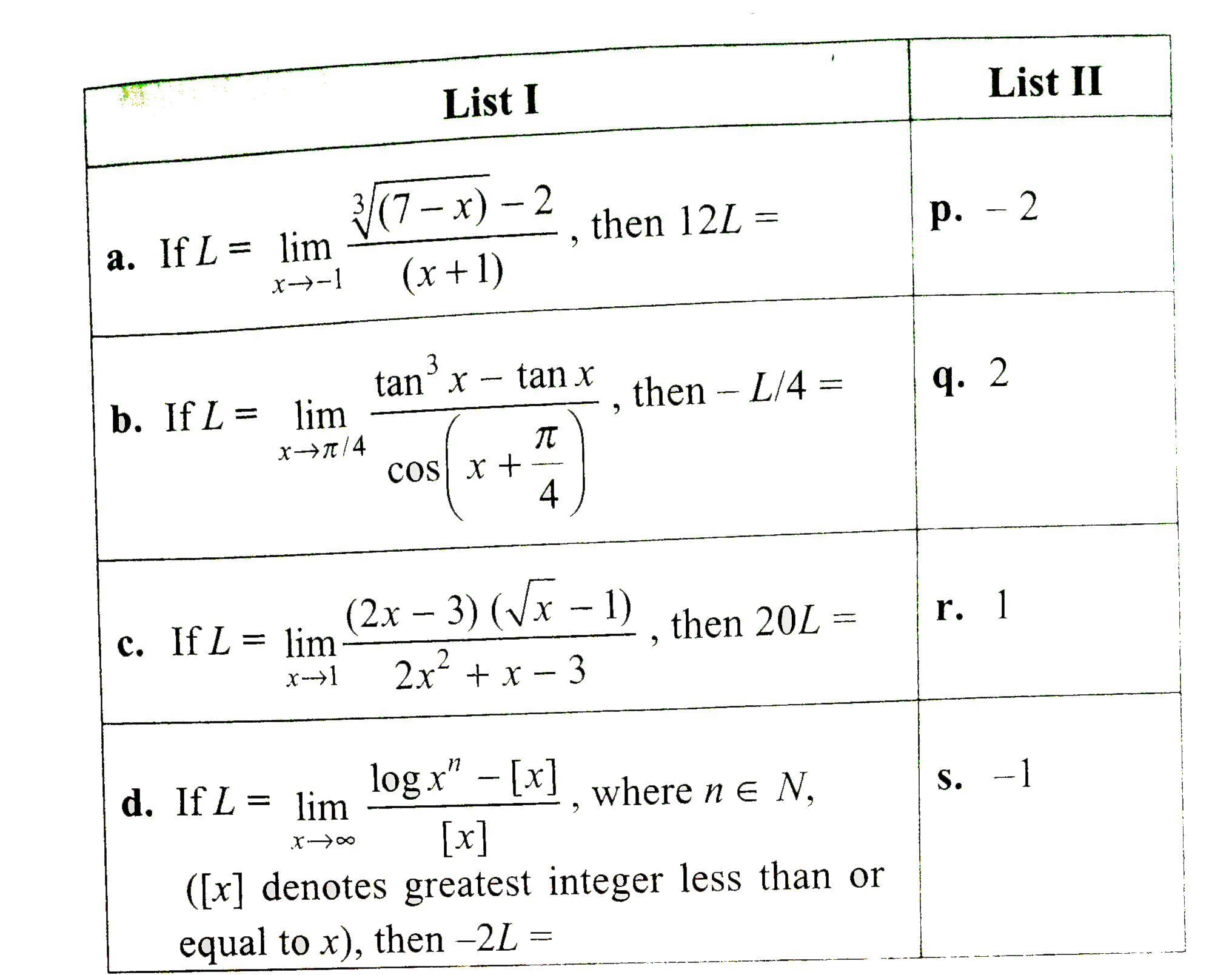Leta1>a2>a3>...>an>1.
p1>p2>p3>...>pn>0 such that p1+p2+p3+...+pn=1.
Also, F(x)=(p1ax1+pnaxn)1/x.
limx→0+F(x) equals Solution in Tamil
abcdsrqp
abcdqpsp
abcdsrpq
abcdppqr
The correct Answer is:C
limx→0+F(x)=limx→0+(p1ax1+p2ax2+...+pnaxn)1/x (1∞ form)
=elimx→0(p1ax1+p2ax2+...+pnaxnx)
=elimx→0(p1ax1 ln a1+p2ax2 ln a2+...+pnaxn ln an)
=e(p1 ln a1+p2 ln a2+...+pn ln an)
=e(ln ap11+ln ap22+...+ln apnn)
=e(ln ap11ap22+...apnn)=ap11.ap22ap33...apnn
Topper's Solved these Questions
- BOOK - CENGAGECHAPTER - LIMITSEXERCISE - Exercise (Matrix)5videos
LIMITS
- BOOK - CENGAGECHAPTER - LIMITSEXERCISE - Exercise (Numerical)23videos
LIMITS
- BOOK - CENGAGECHAPTER - LIMITSEXERCISE - Exercise (Multiple)18videos
LIMITS
- BOOK - CENGAGECHAPTER - JEE 2019EXERCISE - Chapter 109videos
JEE 2019
- BOOK - CENGAGECHAPTER - LINEAR COMBINATION OF VECTORS, DEPENDENT AND INDEPENDENT VECTORSEXERCISE - DPP 1.210videos
LINEAR COMBINATION OF VECTORS, DEPENDENT AND INDEPENDENT VECTORS
Similar Questions
Match the following lists:
 03:18View Solution
03:18View SolutionThe reciprocal of the value of: (lim)n→∞(1−122)(1−132)(1−142)(1−1n2)is
03:14View SolutionLet f(x)={1+2xa,0≤x<1ax,1≤x<2.If(lim)x→1f(x)eξsts,thenais 1 (b) −1 (c) 2 (d) −2
05:09View SolutionIf y = y(x) is the solution of the differential equation, xdydx+2y=x2 satisfying y(1) = 1, then y(12) is equal to
01:58View SolutionThe number of integral values of p for which (p+1)ˆi−3ˆj+pˆk,pˆi+(p+1)ˆj−3ˆk and −3ˆi+pˆj+(p+1)ˆk are linearly dependent vectors is q
05:01View SolutionIf n is a natural number such that n=P_(1)^(a_(1))P_(2)^(a_(2))P_(3)^(a_(3))...P_(k)^(a_(k)) where p_(1),p_(2),...p_(k) are distinct primes then minimum value of ln n is:
03:44View Solutionif (1+x)^(n)=p_(0)+p_(1)x+p_(2)x^(2)+--+p_(n)x^(n) the value of p_(1)-p_(3)+p_(5)+...
03:47View SolutionLet a_(1) p_(2)>...p_(n)>0 such that p_(1)+p_(2)+p_(3)+p_(n)=1. Also F(x)=(p_(1)a_(1)^(x)+p_(2)a_(2)^(x)+...+p_(n)an^(x))^((1)/(z)) Compute
05:07View SolutionIf (1+x)^(n)=p_(0)+p_(1)x+p_(2)x^(2)+....+p_(n)x^(n) then (p_(0)-p_(2)+p_(4)-p_(6)+....)/(p_(1)-p_(3)+p_(5)-p_(7)+......)=
09:04View SolutionLet p_(1),p_(2),...,p_(n) and x be distinct real number such that (sum_(r=1)^(n-1)p_(r)^(2))x^(2)+2(sum_(r=1)^(n-1)p_(r)p_(r+1))x+sum_(r=2)^(n)p_(r)^(2)<=0 then p_(1),p_(2),...,p_(n) are in G.P.and when Statement 2: If (p_(2))/(p_(1))=(p_(3))/(p_(2))=...=(p_(n))/(p_(n-1)), then p_(1),p_(2),...,p_(n) are in G.P.
04:10View SolutionLeta1>a2>a3>...>an>1.
p1>p2>p3>...>pn>0 such that p1+p2+p3+...+pn=1.
Also, F(x)=(p1ax1+pnaxn)1/x.
limx→∞F(x) equals05:51View SolutionProve that 1+1⋅1P1+2⋅2P2+3⋅3P3+…+n⋅nPn=n+1Pn+1.
05:21View SolutionThe value of nP1+nP22!+nP33!+......+nPnn!
View Solution(1+x)n=p0+p1x+p2x2+…+pnxn , then p0+p3+p6+….. =
02:11View SolutionLet Pn=aPn−1−1,∀n=2,3,..., and let P1=ax−1, where a∈R+. Then evaluate limx→0Pnx.
04:25View Solution

